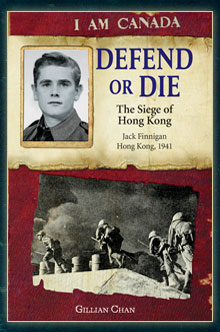| ________________
CM . . .
. Volume XXI Number 24 . . . . February 27, 2015
excerpt:
With the 70th anniversary of D-Day being celebrated in 2014, many people may have forgotten that Canadian armed forces personnel weren’t just involved in liberating Europe from the Germans during World War II, but they also participated in the Pacific theatre of combat. It is this conflict with the Japanese forces that Chan addresses in Defend or Die: The Siege of Hong Kong. Chan’s narrator is 18-year-old Jack Finnigan. In 1941, to avoid facing criminal charges for assault, Jack has “volunteered” to join the Royal Rifles of Canada. Along with a regiment of the Winnipeg Grenadiers, Jack’s unit takes a train across Canada to Vancouver before boarding a passenger liner that has been converted into a troop ship. It is only after the vessel leaves Hawaii that the soldiers learn their destination - the British colony of Hong Kong where they will reinforce the local garrison. The book begins in January 1942, with Jack in a Japanese prisoner of war camp on Hong Kong Island, and Chan uses this opening section to explain how Jack acquired the blank ledger that he uses as a secret diary to record the events around the battle for Hong Kong as well as his experiences as a POW. The story then jumps briefly back in time to October 1941, in Toronto as Jack provides readers with part of his civilian backstory. Although Jack ends his diary entries in January 1943, the point at which he is being shipped to Japan to become a slave laborer in a coal mine, Chan provides an “Epilogue” set in Toronto in February 1946. In it, readers, among other things, learn what happened to some of Jack’s fellow POWs, in particular Sergeant Oldham, Ike Caplan and Paddy Houlihan, as well as the diary Jack had been forced to abandon. Chan’s use of dated diary entries most effectively allows Jack to share the ongoing happenings in the POW camp while being able to recall and record his unit’s battlefield experiences as they fought valiantly, but unsuccessfully, in their defense of Hong Kong. Because the actual direct combat with the Japanese troops lasted a little more than a week in December of 1941, while Jack’s time spent in the Hong Kong Island POW camp spanned more than a year, readers will likely take away more from his latter experience than the former. Since Japan was not a signatory to the Geneva Convention regarding the humane treatment of POWs, the prison camp conditions were extremely harsh, with the malnourished, physically abused and lice and bed bug infested POWs contracting serious illnesses like dysentery. However, as Jack observes in March 1942, “War changes people. I’ve seen things in the last few months that I never want to see again. It brings out the best and the worst in people and you don’t know what it will do to you until you’re there.” For example, right from the outset of the Royal Rifles’ training in Canada, Sergeant William “Bloody” Oldham, a regular army NCO, had seemingly taken a strong dislike to Jack, but during combat in Hong Kong and the period of their shared imprisonment in the POW camp, Jack came to understand and value Oldham’s tough love approach to commanding his untried soldiers. Defend or Die closes with a succinct nine page “Historical Note”, eight pages of b&w period photos, including one of the front page of the December 23, 1941, issue of the Winnipeg Free Press and two maps. As part of a concluding three page “Author’s Note”, Chan explains her family’s connection to this particular historical event. Highly Recommended. Dave Jenkinson, CM’s editor, lives in Winnipeg, MB.
To comment on this title or this review, send mail to cm@umanitoba.ca.
Copyright © the Manitoba Library Association. Reproduction for personal use is permitted only if this copyright notice is maintained. Any
other reproduction is prohibited without permission.
CM Home | Next Review | Table of Contents for This Issue - February 27, 2015 | Back Issues | Search | CM Archive | Profiles Archive |
